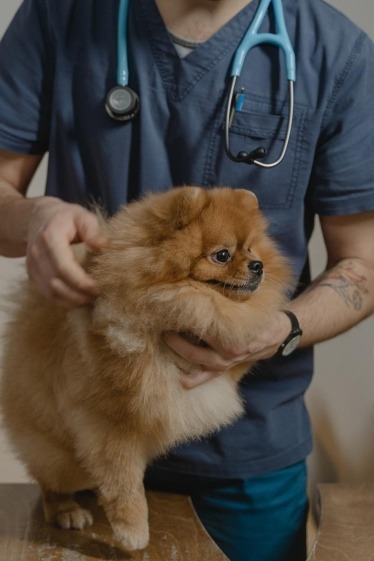Trouble breathing affects dogs of all kinds and can be a sudden or gradual problem. If your furry friend is having trouble taking in air, it’s important to get him help as soon as possible, as breathing difficulties can quickly become life-threatening. You might even ask yourself: why is my dog having trouble breathing all of a sudden?
Dogs suffer from different trouble breathing problems like Dyspnea, Panting, or Tachypnea (rapid breathing) due to a variety of causes such as pulmonary diseases (pulmonary edema, canine heartworm disease, pneumonia, etc.), cardiac issues (congestive heart failure and arrhythmias) and Allergies, which can cause inflammation and swelling in the airways.
Let’s take a closer look at some of the most common causes of trouble breathing in dogs, its symptoms, and what you can do to help your pup.
Why Is My Dog Having Trouble Breathing All of a Sudden?

Your dog’s health relies on the efficiency of the respiratory system in delivering oxygen to the red blood cells (RBCs). If your dog is having trouble breathing suddenly, it may indicate something is wrong with this system or other health problems.
Any dog, regardless of age, breed, or sex, can experience difficulty breathing, but some breeds and types of dogs are more susceptible to specific underlying causes of breathing difficulties.
Large Dog Breeds: They are more susceptible to congestive heart failure.
Small Dog Breeds: Some small dog breeds like Italian Greyhounds, Poodle, and Maltese are more likely to experience chronic bronchitis, tracheal collapse, or chronic mitral valve disease.
Small Toy Breeds: Small toy breeds like the Pomeranian, Chihuahua, & Yorkshire Terrier are more likely to develop tracheal collapse.
Short-Faced Breeds of Dogs: Short-faced breeds of dogs (like bulldogs) have a higher chance of developing congenital breathing difficulties due to their elongated soft palates & narrowed nostrils. They may also suffer from tumors near the heart or in the lungs.
How a Dog’s Respiratory System Works

Dogs have a respiratory system much like our own, made up of the same parts: The nose, throat (pharynx), voice box (larynx), trachea (windpipe), bronchi, and lungs. To provide oxygen to the body cells:
- Air is taken through the nose or mouth and then into the lungs.
- Once in the lungs, oxygen passes into the blood and is then carried to all body cells.
- Carbon dioxide, a waste product produced by the cells, travels back through the blood to the lungs, where it is exhaled.
Normal Respiratory Rate of Dogs
Knowing the difference between normal and trouble breathing rates is essential for pet parents. The average respiratory rate for healthy dogs at rest is 20 to 34 breaths/minute. However, rapid breathing can be due to normal factors such as excitement, temperature, warmth, and exercise.
Pet parents should know how their dog breathes at rest, during walking (which is when you should be using a no-pull dog harness), and after playing. If they see a sudden change, it’s best to seek medical attention immediately.
3 Most Important Types of Breathing Problems in Dogs
There are many different types of dog breathing problems that can occur. The three most important include:
1. Labored Breathing or Dyspnea

Dyspnea in dogs is a situation where the dog works much harder than usual to breathe. It can cause a panting noise, and the dog may take deep breaths or appear to be struggling.
Causes
A wide range of issues can cause Dyspnea in dogs. It could be as simple as a foreign object stuck in their throat or something more severe like heart failure or pneumonia. Other potential causes include:
- Heart enlargement
- Viral, fungal, or bacterial infection
- Pulmonary edema
- Injury or partial paralysis of the chest wall
- Allergies
- Kennel cough or infectious tracheobronchitis
- Reaction to toxins or poison from botulism or tick bite
- Heartworm infection
Symptoms
Dogs with dyspnea exhibit the following symptoms, which is why it’s essential to take note and get them to a vet as soon as possible.
- Irregular chest and stomach movement
- Flared nostrils while breathing
- Sticking out their elbows from the body
- Holding their head and neck low and extended out in front of the body
- Noisy breathing or choking sounds
- Open mouth breathing (but not necessarily panting)
2. Heavy Panting

Panting is normal for dogs to cool themselves off and regulate their body temperature. However, if your dog suddenly starts panting heavily with an open mouth and can’t catch its breath, it could be a sign of an underlying medical issue.
Causes
Your dog may be panting excessively fast for a variety of reasons, but significant potential causes include the following:
- Being overweight or obese
- Medication side effects
- Pain or discomfort
- Metabolic acidosis (more acid production in the body)
- Elevated body temperature (such as during excessive exercise or fever)
- Heatstroke
- Excitement or anxiety
- Elevated thyroid hormone levels
Dogs may pant if they are suffering from Dyspnea or Tachypnea, both caused by various factors.
Symptoms
Important symptoms of panting include:
- Tongue hanging out
- Fast breathing
- Wide open mouth
- Shallow breaths
3. Rapid Breathing (Tachypnea)

Dogs that breathe abnormally fast for no reason are said to be tachypneic (suffering from tachypnea).
Symptoms
Symptoms of tachypnea in dogs include:
- Mouth of the dog may be closed or partially open while breathing
- Faster breathing rate than normal
- Breathing more shallowly than normal
Causes
Dogs suffering from Dyspnea may also show signs of tachypnea, other causes include:
- Hypoxemia or low oxygen levels in the blood
- Anemia or low red blood cell levels
- Pulmonary thromboembolism (blood clots within dog’s lungs)
When a Dog’s Labored Breathing Causes Pain

Labored breathing in dogs causes pain when their airways are constricted or have fluid buildup in their lungs, a condition known as pulmonary edema. This fluid buildup can be caused by exposure to toxins, trauma, or underlying medical conditions, such as heart disease or liver disease. Putting on a no-pull dog harness can further worsen your dog’s breathing problem if not used correctly. Symptoms of pulmonary edema in dogs include:
- Coughing
- Cracking noises while breathing
- Weakness
- Wheezing
- Collapse
- Distended jugular vein
- Exercise intolerance
- Blue lips or tongue
Diagnosis of Troubled Breathing

It’s essential to seek veterinary attention as soon as possible if your dog has trouble breathing. Your vet will likely ask for a complete medical history, including any recent changes in diet or exercise and potential exposure to toxins or allergens.
Your veterinarian will examine your dog’s breathing and listen to his chest for specific sounds, such as choking sounds, which might help identify the problem. Your vet may also suggest the following:
- A complete blood count is to check for underlying illnesses that could be causing difficulty breathing.
- Chest X-rays to look for structural issues, such as a collapsed lung or heart enlargement.
- In some cases, a bronchoscopy may be necessary to get a closer look at the trachea and bronchi. It involves inserting a thin tube with a camera through the nose or mouth, allowing the vet to examine and collect samples from the respiratory tract.
- Electrocardiogram to check for heart problems
- Ultrasound imaging to assess the heart and lungs
- Specialized blood tests to evaluate organ function
- Fluid samples may also be taken for further analysis
- Tissue biopsies may be necessary to confirm a diagnosis
By gathering information and conducting various diagnostic tests, your vet can determine the cause and provide the appropriate treatment plan.
How To Treat Breathing Difficulties in Dogs

Depending on the underlying your dog’s breathing problems, your vet may recommend using a no-pull dog harness and the other treatment options include:
- Oxygen Therapy: To improve oxygen levels in the blood.
- Anti-inflammatory Medicines: To reduce irritation and swelling in the airways in conditions such as asthma or pneumonia.
- Diuretic Medication: Eliminates excess fluid from the body and reduces strain on the heart and lungs.
- Thoracentesis: Removal of fluid from the chest cavity, relieves pressure on the lungs and improves breathing.
- In Severe Cases: Surgery may be necessary to remove a tumor or repair damaged tissue.
How Can I Give My Dog Oxygen at Home?
Stationary home oxygen concentrators for dogs are low-budget devices that can be used continuously inside the house. Portable battery-operated mobile ones, as the name suggests, can be carried outside and do not require a refill. The concentrators make their own oxygen.
How Long Can Dogs Live With Lung Disease?

The prognosis for dogs with lung disease varies greatly depending on the specific disease and how early it is diagnosed and treated. Some pulmonary diseases, such as pneumonia, may have a good prognosis with proper treatment, while others, like chronic bronchitis, may have a more guarded prognosis and may require long-term management.
It is important to work closely with your veterinarian to determine the best course of treatment for your dog’s specific condition and to monitor its progress. In some cases, dogs can live for years with proper management of their lung disease. In others, the disease may be progressive and ultimately fatal.
Most veterinarians say that many dogs will die from progressive lung failure within the next 12 to 18 months.
Is Lung Disease Curable in Dogs?

The answer to this question depends on the specific type of lung disease and its severity. Some forms, like pneumonia or bronchitis, can often be treated successfully with medication and supportive care. Other types of lung disease, such as chronic obstructive pulmonary disease (COPD) may not have a cure but can be managed with long-term treatment plans.
It is important to consult with your veterinarian on the best treatment options for your dog’s specific lung disease and work together to provide the best quality of life for your furry friend.
Additionally, it is important to note that prevention is key in lung disease. Vaccinations, parasite control, and minimizing exposure to second-hand smoke can all help prevent lung disease in dogs.
Final Thoughts
Breathing difficulties can be a scary, sudden problem for dogs and it’s important to seek veterinary attention immediately. When it comes to finding the cause of breathing trouble in dogs, there are many possible factors at play and it is important to consult with your veterinarian for a proper diagnosis and treatment plan. Prevention, when possible, is always the best option for keeping your furry friends healthy and happy.
But, if your dog is experiencing trouble breathing, don’t wait – make sure to seek immediate veterinary attention. Your pup’s life may depend on it!





